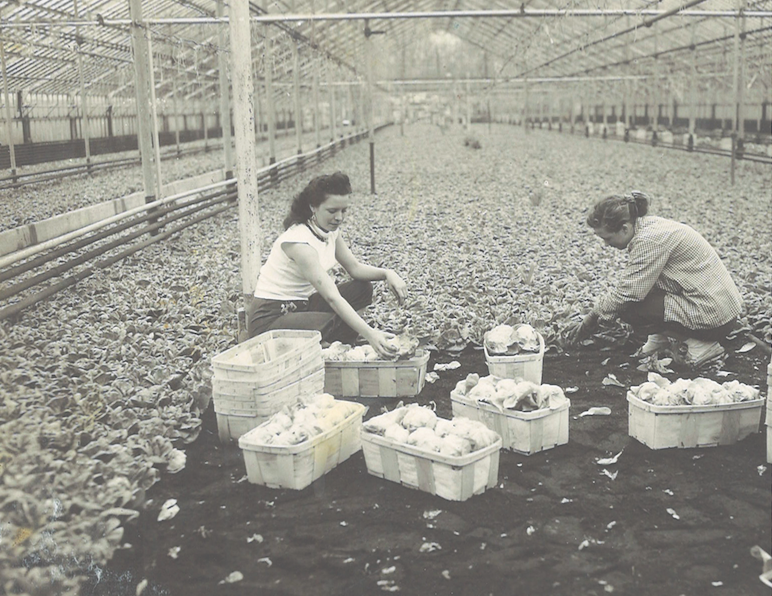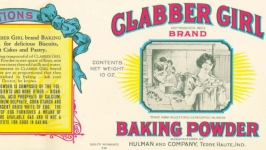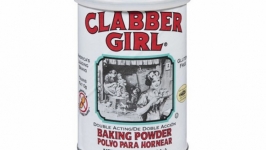Acres of Vegetables Under Glass: Davis Gardens, A Long-Lost Secret of Terre Haute
“On the Banks of the Wabash, Far Away,” Indiana’s state song, written by Terre Haute native Paul Dresser, is but one of the many things Terre Haute has contributed to our state history. As Indiana celebrates its bicentennial, so does Terre Haute—possibly one of the most interesting, yet overlooked, cities in the state.
Terre Haute has a rich history that many know: from Hulman & Company, the industrialists that created Clabber Girl Baking Powder and saviors of the Indianapolis Motor Speedway, to the internationally relevant Sheldon Swope Art Museum, with an amazing collection of American art. Much of the city’s history, however, remains memories from the past; few know that the seventh largest brewery in the United States, Terre Haute Brewing Company, was once located here, or that the banks of the Wabash were once lined with distilleries, including the world’s largest at one time.
Terre Haute has a long association with many types of food and beverage production. A few examples were Anne Page products, made by the Quaker Maid Company and distributed by the A&P Co., which were available nationwide, and the Miller-Parrott Baking Co., which was known for crackers. However, there was also a strong community of growers in and around the city. To me, the most interesting of these was the J.W. Davis Company.
Locally known as Davis Gardens, the operation was located on US 41 roughly three miles south of the intersection with US 40, commonly referred to as the Crossroads of America. These two arteries were important to Terre Haute in general, and Davis Gardens in particular, in that they were the two longest federal highways before the interstate system was adopted. In addition, US 40 was originally the National Road, the first federal highway and conduit for much of our early westward expansion. Being situated at the convergence of the two main arteries for road transport gave the company a huge advantage. They could move products from Terre Haute to not only other cities, but also to ports for international sale. The company also sent produce by rail, and Terre Haute was once a robust rail hub. In addition, with the opening of Hulman Field (later Terre Haute International Airport), the J.W. Davis Company started to utilize airfreight. At one time, Davis Gardens produce was available on luxury ocean liners, at the tables of restaurants around the globe and even in the White House.
Started in 1914, the J.W. Davis Company was unique in that it was an indoor production facility. Originally, there were two or three greenhouses and the focus was on flowers; however, they would grow into a facility that had at least 39 greenhouses covering over 35 acres and growing primarily vegetables. By 1974, when they ceased operations, Davis Gardens was the largest indoor food production facility in the world. The facility was so large that, until recently, the outline of the greenhouses was still visible on satellite maps of Terre Haute. The facility even had its own coal-fired power plant. In addition to other uses, the plant produced steam that heated the greenhouses when needed. The temperature, moisture and soil pH were completely controlled to provide a consistent growing environment.
The gardens had their own beehives housed inside 10 of the greenhouses in order to pollinate the plants year round. And the operation was certainly year round; with the exception of August and September, when the soils were prepped and competition from other producers was high, the greenhouses were always producing flowers or vegetables. Even in the down months, the company was busy preparing for their busy winter season.
Although originally focusing on flowers, the J.W. Davis Company is mostly remembered as a producer of vegetables. In an era where the seasonality of produce limited the availability of vegetables in the winter months, Davis Gardens could offer fresh produce year round. While they produced a number of varied vegetables, they were particularly known for a few specific crops. It is commonly reported that the J.W. Davis Company was the largest tomato farm in the nation at one time, and definitely supplied hothouse tomatoes to Chicago in the winter months. There are reports from the 1960s that over two million pounds of tomatoes were cultivated annually. Cucumbers were another of their staples; many of the historical photos available show cucumbers growing in the greenhouses. Supposedly the cucumbers were good for salads, and both the tomatoes and cucumbers are seen advertised as “salad” varieties.
Salad was an important aspect of the Davis Gardens operations. In addition to the Terre Haute facility, the J.W. Davis Company had smaller greenhouses in Davenport, Iowa, and Aurora, Illinois. These were supposedly used for growing even more of the real innovation of the company: Bibb lettuce. While not created by the J.W. Davis Company (the hybrid is attributed to a veteran of the War of 1812, Lt. John Bibb), nor initially brought to the commercial market by them, Davis Gardens was the first company to produce this lettuce on a truly massive scale.
They solved the problem of how to grow the lettuce for much of the year, reportedly planting the first crops in September and growing continuously through May of the next year. An article from the Saturday, August 5, 1962, edition of the Indianapolis Star reported that “Beginning next month [September], the Davis company workers will sow 80,000 to 250,000 Bibb lettuce seedlings weekly. Then from October through May about 3,500 five-pound baskets of Bibb will be harvested weekly.”
This was supposedly only at the Terre Haute facility; the other two locations would have added even more capacity. The company had a system by which up to 10,000 seeds could be planted per hour. This was their real innovation: year-round lettuce at a time when lettuce had previously only been available as essentially a spring and fall crop. With the hothouse tomatoes, salad cucumbers and Bibb lettuce, one could make a salad in any season.
So why did such a large company, with international sales and a huge facility, fail to survive into the current era? There are a few reasons. The first is in how they powered their facilities. By 1974, new regulations were starting to change the landscape of the United States. The Environmental Protection Agency had been established and the Clean Air Act passed, which made it more difficult to operate older power plants like that utilized by Davis Gardens. By 1979, even the smokestacks for the power plant had been demolished.
Another factor was related to the J.W Davis Company’s early success. By 1967 Interstate 70 had reached Terre Haute, crossing over US 41 just north of Davis Gardens. While the interstate system was valuable to companies like Davis Gardens, it also made it easier for similar companies to move produce. Specifically, companies in California and Florida were now able to grow produce year round because of the favorable climate in those states without the need for expensive greenhouse operations. After the 1970s, as fuel prices lowered and trade restrictions changed, vegetable production also moved into a global market. Few companies like the J.W. Davis Company could compete in the changing landscape of the produce market.
As a local hobby grower and passionate advocate for local food, I find it heartening that there is a resurgence of similar truck-farm-style food production. There are urban farms and small-scale producers relearning how to provide food on a local level. While places like Davis Gardens might not be currently feasible, there is hope that such operations can blossom with a new focus on fresh and local foods. In some ways, Terre Haute is lagging behind that movement; however, the defining model for how it can work is still part of our local community and maybe a similar operation can be one of the ways that Terre Haute leads the state into the next 200 years.







